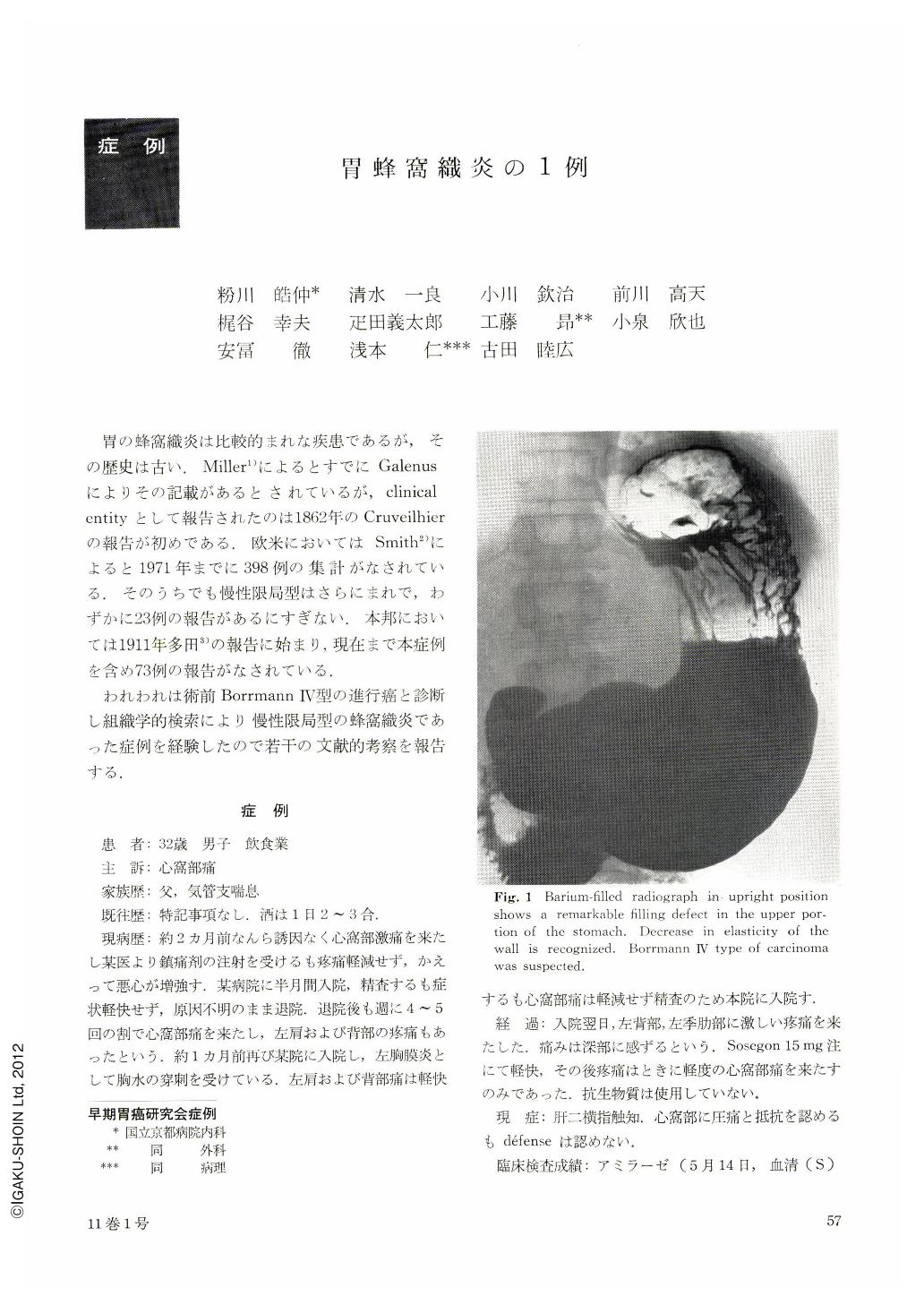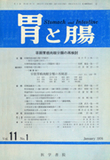Japanese
English
- 有料閲覧
- Abstract 文献概要
- 1ページ目 Look Inside
胃の蜂窩織炎は比較的まれな疾患であるが,その歴史は古い.Miller1)によるとすでにGalenusによりその記載があるとされているが,clinical entityとして報告されたのは1862年のCruveilhierの報告が初めである.欧米においてはSmith2)によると1971年までに398例の集計がなされている.そのうちでも慢性限局型はさらにまれで,わずかに23例の報告があるにすぎない.本邦においては1911年多田3)の報告に始まり,現在まで本症例を含め73例の報告がなされている.
われわれは術前Borrmann Ⅳ型の進行癌と診断し組織学的検索により慢性限局型の蜂窩織炎であった症例を経験したので若干の文献的考察を報告する.
Phlegmonous gastritis is a disease rarely encountered in clinical investigation. This condition was supposedly first described by Galenus in the second century. The number of reported cases so far is 398 cases in European countries and 73 cases in Japan, including our own case.
The present case is a 32-year-old male with chief complaint of persistent epigastralgia of two months' duration. X-ray examination revealed a remarkable filling-defect in the upper portion of the stomach. Borrmann Ⅳ type of gastric carcinoma was suspected. Operation was done, showing chronic localized phlegmonous gastritis as confirmed later by pathological investigation. Pancreatic cyst was recognized in the body of the pancreas. Consistence of the pancreas was very firm and chronic pancreatitis was suspected.
Two routes of infection are considered, namely primary and hematogenous. Homolytic streptococcus is chiefly demonstrable. Staphylococcus and mixed infection, however, are detected in Japan with the same incidence as streptococcus infection.
Symptoms and signs are not pathognomonic. Acute abdomen is suspected in many cases. Guzzetta has mentioned an interesting sign, Deiningen's sign, noted by Deiningen in 1879: that is, the pain in this condition is relieved when the patient sits up.
The pathological classification is seemingly confused. Konjetzny classified the disease into two types, diffuse and localized (diffuse progressive and localized unprogressive). Sundberg classified it into abscess, phlegmonous gastritis and mixed type. Smith's classification is acute diffuse and chronic localized type. The main cause of confusion in classification is ambiguous definition of ‘acute’ and ‘chronic’. Starr has proposed the criteria concerning chronic case as follows: 1) History reveals a prolonged illness of more than a few week's duration without rapid or sudden progression of symptoms and 2) minimal or no fever, tachycardia or leukocytosis. This criterion seems very useful. If the lesion begins as a localized cellulitis in the submucosal layer as mentioned by Miller, chronic diffuse type or acute localized one may be rare. In fact, Gillespie has reported such a case of acute localized type and mentioned that this is a rare type. Chronic diffuse type of phlegmonous gastritis will be recognized in the course of healing stage of acute diffuse one. However, this type is too few in number to be analyzed.
According to the course of the disease and by the pathological examination, the present case can be diagnosed as a chronic localized type. Moreover, it is very interesting that the lesion was located in the upper portion of the body of the stomach, since this type is commonly found in the antrum.
It is interesting to review the history of therapy of this disease. In 1927, Gerster recommended resection as the procedure of choice. Eliason suggested gastrotomy with transmucosal incision and drainage of the abscess. Culter mentioned that the operation was contraindication for acute phlegmonous gastritis. The discovery of antibiotics was an epochmaking affair in the therapy of inflammatory diseases. Barrier treated three cases with penicillin and sulfonamides and two cases recovered completely. It is very interesting that Miller stated that if the disease was encountered on exploratory laparotomy, the abdomen should be closed and the patient should be placed on antibiotic therapy.
However, Starr demonstrated the importance of operation, showing the 83% survival rate in the operated case, whereas 33% in nonoperation case. With increase in number of cases of operation, the mortality has been remarkably decresed. Sandberg, in 1919, showed 92% of mortality, and Eliason demonstrated 84% in 1938. Starr and Valencia-Parparcen showed 48% and 33% of mortality, respectively. Recently, Miller collected 25 cases of phlegmonous gastritis in the literature, and showed 100% mortality in medical treatment, while the surgical mortality was 18%.
Reviewing the literature, the authors propose that early recognition of this disease and prompt surgical treatment must be emphasized.

Copyright © 1976, Igaku-Shoin Ltd. All rights reserved.


